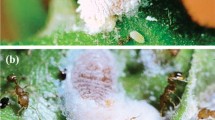Abstract
Symbioses between ants and plants are widespread in the tropics. Trees are usually defended by their ants, while epiphytic plants probably obtain mineral nutrients via the ants. In northern Australia three Malesian genera of ant-epiphytes are found: Myrmecodia and Hydnophytum (Rubiaceae) and Dischidia (Asclepiadaceae). Myrmecodia and Hydnophytum form large tubers with cavities, some of which have specialized warts, probably for absorption. In Dischidia the leaves form sacs which are entered by adventitious roots. Ants, usually Iridomyrmex cordatus, occupy these cavities and sacs. They deposit organic remains in the cavities with warts. Radio-isotopes fed to the ants are later absorbed by the plants. The behaviour of the ants and other occupants of the ant-plant are discussed in relation to the symbiosis.
The three species of Myrmecodia and two of Hydnophytum in Australia require moist tropical conditions, but are absent from the rain forest. In coastal and savanna vegetation, where other epiphytes are rare, they are abundant, probably due to improved mineral nutrition from the symbiosis. In Dischidia transpirational water loss may be reduced by the symbiosis, enabling the plants to use drier habitats.
Illustration and a key to Australian species are given together with nomenclatural notes. Species of ants which have been found in ant-plants are tabulated.
Access this chapter
Tax calculation will be finalised at checkout
Purchases are for personal use only
Preview
Unable to display preview. Download preview PDF.
Similar content being viewed by others
References
Bailey, F. M., 1900. The Queensland Flora, 773–775. Diddams, Brisbane.
Bailey, F. M., 1909. Comprehensive Catalogue of Queensland Plants. Queensland Government, Brisbane.
Barrett, C., 1928. Ant-house plants and their tenants. Victorian Naturalist, 133–137.
Beaglehole, J. C., 1962. The Endeavour Journal of Joseph Banks 1768–1771. Trustees of the Public Library of New South Wales, in association with Angus and Robertson, Sydney.
Beccari, O., 1884–6. Genoa: Tipografia del istitudo Sordo-Muti. Malesia, 2.
Bequaert, J., 1922. Ants and their diverse relations to the plant world. Bull. Am. Mus. Nat. Hist. 14: 522–528.
Cochrane, G. R., 1963. A physiognomic vegetation map of Australia. J. Ecol. 51: 639–655.
Common, F. I. B. & Waterhouse, D. F., 1972. Butterflies of Australia. Angus and Robertson, Sydney.
Dahl, F., 1901. Das Leben der Ameisen im Bismarck-Archipel. Mitt. zool. Mus., Berlin 2: 1–69.
Forbes, H. O., 1885. A Naturalist’s Wanderings in the Eastern Archipelago. Sampson, Low, Marston, Searle and Rivington, London.
Huxley, C. R., 1978. The ant-plants Myrmecodia and Hydnophytum ( Rubiaceae) and the relationships between their morphology, ant occupants, physiology and ecology. New Phytol. 80: 231–268.
Huxley, C. R., 1980. Symbiosis between ants and epiphytes. Biol. Rev. 55: 321–340.
Jack, W., 1823. Account of the Lansium and some other genera of Malayan plants. Linn. Soc. Lond., Trans. 14: 122–124.
Janzen, D. H., 1974. Epiphytic myrmecophytes in Sarawak, Indonesia: mutualism through the feeding of plants by ants. Biotropica 6: 237–259.
Jermy, A. C. & Walker, T. G., 1975. Lecanopteris spinosa- a new ant-fern from Indonesia. Fern Gazette 11: 165–176.
Mann, W. M., 1919. The ants of the British Solomon Islands. Bull. Mus. Comp. Zool. Harv. 63: 362–406.
Mann, W. M., 1921. The ants of the Fiji Islands. Bull. Mus. Comp. Zool. Harv. 69: 469–472.
Miehe, H., 1911. Über die javanische Myrmecodia und die Beziehung zu ihren Ameisen. Biol. Zbl. 31: 733–737.
Monteith, G. B., 1974. Focus on Cape York. Rep. Fauna Subcomm. Entomol. Soc. Queensl., September 19th.
Rickson, F. R., 1979. Absorption of animal tissue breakdown products into a plant stem: the feeding of a plant by ants. Am. J. Bot. 66: 87–90.
Treub, M., 1883. Sur le Myrmecodia echinata Gaudich. Ann. Jard. Bot. Buitenz. 3: 129–159.
Treub, M., 1888. Nouvelles reherches sur le Myrmecodia de Java. Ann. Jard. Bot. Buitenz. 7: 191–212.
Valeton, T., 1927. Die Rubiaceae von Papuasien. Bot. Jahrb. 61: 127–150.
Walter, H. 1964. Vegetation der Erde, 452. Gustav Fischer, Jena.
Waterhouse, G. A., 1928. Notes on Australian Lycaenidae, Pt.4. Proc. Linn. Soc. N.S.W. 53: 405–407.
Editor information
Editors and Affiliations
Rights and permissions
Copyright information
© 1982 Dr W. Junk Publishers, The Hague
About this chapter
Cite this chapter
Huxley, C.R. (1982). Ant-epiphytes of Australia. In: Buckley, R.C. (eds) Ant-plant interactions in Australia. Geobotany, vol 4. Springer, Dordrecht. https://doi.org/10.1007/978-94-009-7994-9_7
Download citation
DOI: https://doi.org/10.1007/978-94-009-7994-9_7
Publisher Name: Springer, Dordrecht
Print ISBN: 978-94-009-7996-3
Online ISBN: 978-94-009-7994-9
eBook Packages: Springer Book Archive




